英语口译基础教程 1. interpreting course
- 格式:ppt
- 大小:552.50 KB
- 文档页数:38

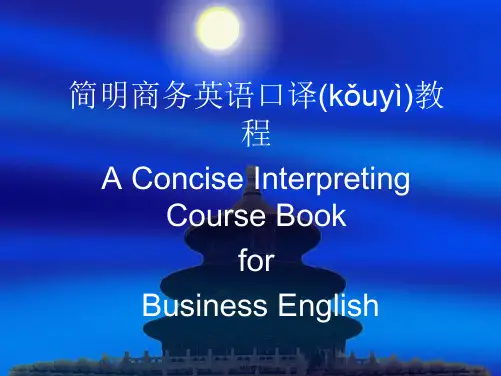

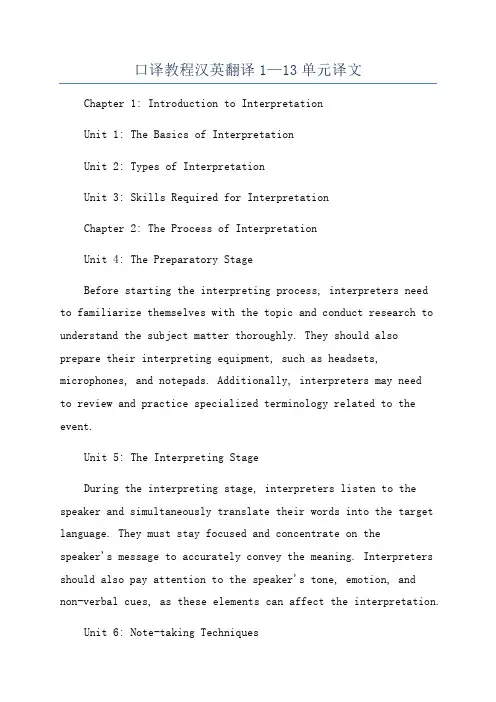
口译教程汉英翻译1—13单元译文Chapter 1: Introduction to InterpretationUnit 1: The Basics of InterpretationUnit 2: Types of InterpretationUnit 3: Skills Required for InterpretationChapter 2: The Process of InterpretationUnit 4: The Preparatory StageBefore starting the interpreting process, interpreters need to familiarize themselves with the topic and conduct research to understand the subject matter thoroughly. They should also prepare their interpreting equipment, such as headsets, microphones, and notepads. Additionally, interpreters may needto review and practice specialized terminology related to the event.Unit 5: The Interpreting StageDuring the interpreting stage, interpreters listen to the speaker and simultaneously translate their words into the target language. They must stay focused and concentrate on thespeaker's message to accurately convey the meaning. Interpreters should also pay attention to the speaker's tone, emotion, and non-verbal cues, as these elements can affect the interpretation.Unit 6: Note-taking TechniquesNote-taking is an essential skill for interpreters.Effective note-taking allows interpreters to retain important information and assist with memory recall during interpretation. Interpreters should develop their own note-taking system and use abbreviations and symbols to jot down key points quickly. However, note-taking should not interfere with active listening and immediate interpretation.Chapter 3: Consecutive InterpretationUnit 7: Introduction to Consecutive InterpretationConsecutive interpretation involves listening to one or several sentences in the source language and then reproducing them in the target language. It requires good memory retention and the ability to accurately convey the meaning. Interpreters should take notes and use their notes as a reference during the interpretation.Unit 8: The Techniques of Consecutive InterpretationInterpreters use several techniques during consecutive interpretation to ensure accurate and fluent delivery. These techniques include paraphrasing, summarizing, clarifying ambiguous statements, and maintaining natural rhythm and pacing. Interpreters should also adapt their interpretation style to match the speaker's tone and style.Unit 9: Consecutive Interpretation PracticeInterpreters can practice consecutive interpretation by engaging in role plays or shadowing experienced interpreters. They can also utilize practice materials, such as speeches, interviews, or articles, to improve their interpretation skills. Regular practice is essential for enhancing memory retention, improving fluency, and perfecting delivery.。
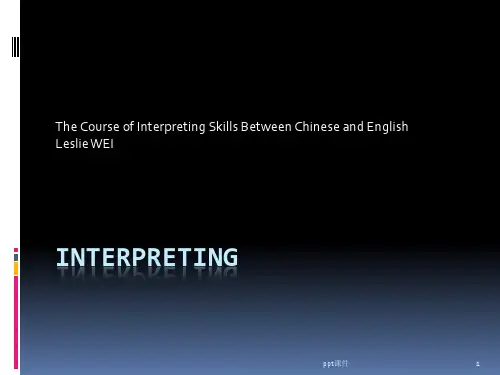
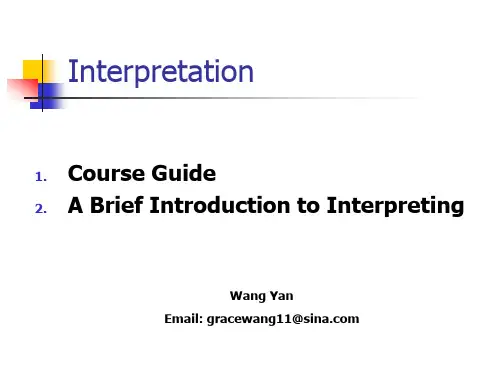
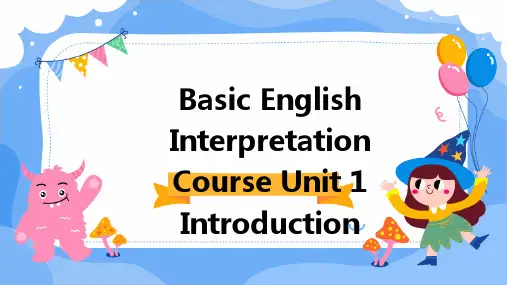
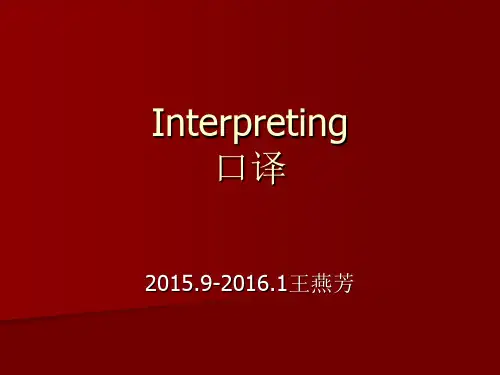
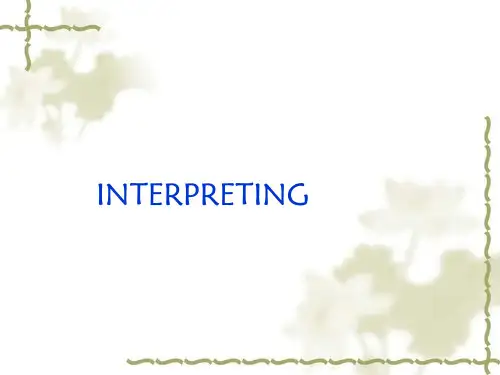
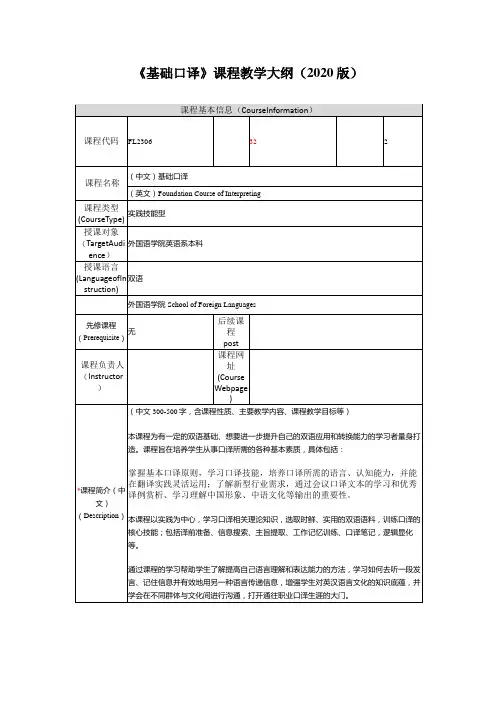

广西民族师范学院外国语学院课程教案课程代码:总学时/周学时:34/2开课时间:2017年2月23日第1周至第17周授课年级、专业、班级:英语(师范教育)2014级4班使用教材:口译基础教研室:英语教研室授课教师:阳琼Lecture1ABriefIntroductiontoInterpreting◇TeachingObjectivesHelpthestudentsachieveabasicunderstandingofinterpreting:itsnature,classification, evaluationcriteria,qualitiesofinterpreter,etc.◇Important&DifficultPoints1.Thenatureandevaluationcriteriaofinterpreting;2.Therequirementsofqualifiedinterpreter.◇Teaching MethodsCommunicativeteachingapproach◇Teaching ProceduresStep1Greeting(3mins)TheTeacherintroducesherselfStep2Lead-in(10mins)Coursedescription.?Step3Overview?of?Interpretation(40mins)1.Definition?of?InterpretationInterpretation?is?a?vocal?translation?to?the?information?delivered?by?vocal?utterance ?and?text.?2.Characteristics?of?Interpretation?*?Unpredictability??*?Bearing?on?big?pressure??????*?Independency??*?Comprehensive?language?and?skill?operations???????*?Extensive?communicative?information3.?Criteria?of?Interpretation?*accuracy?*fluency??4.?Process?of?Interpretation5.InterpreterQualificationRequirementsConformtotheForeignaffairsdisciplineSolidbilingualbasisCompleteabilityofutteranceQuick-mindedLearnedGoodmannerStep4Practices:Dialogue&passageinterpreting(30mins)会展中心介绍Vocabulary:国际会展中心InternationalExhibitionCenter仓储warehousing室内展厅indoorexhibitionarea室外展厅outdoorexhibitionarea中国国际投资贸易洽谈会ChinaInternationalFairforInvestmentandTrade国际石材展InternationalStoneFair体博会Sports&LeisureGoodsFair大堂lobby拖车trailer展位both多功能multi-functional装卸平台loadingplatformStep5Assignments(2mins)PreviewthecontentofUnit1.Lecture2IdentifyingKeyWordsinSentences◇TeachingobjectivesAttheendofthelesson,studentsshouldbeableto:1.identifykeywordsinsentenceswhilelisteningtothesourcelanguage;2.masterkeywords,expressionsandsentencesonareception3.improveinterpretingskillsandpractice◇Keypointstheabilitytoidentifykeyinformationthroughkeywords◇TeachingAllotment:2periods◇TeachingMethods:communicativeapproach;audio-lingualapproach◇TeachingProcedures:Step1Greeting&Warming-upStep2Interpretingskills(10mins)PleasegothroughPart1quicklyandfindtheanswerstothefollowingquestions.1)Whatstandardsdointerpretershavetomeetasforlistening?2)Whatistheso-called“keyword”inasentence?3)Fromwhichfourperspectivescanweidentifykeywordsinasentencetograspthekeyinformation?Step3Practices(65mins)(1)Sentenceinterpreting(15mins)1)对不起,您是来自英国电信(BritishTelegraph)的LisaAnderson女士吗?2)自上次在巴黎匆匆一晤,我们都好几年没见面了。
专业课课程教学大纲模板口译⑴Interpretation (1)一、基本信息(必填项)课程代码:课程学分:2.0面向专业:英语课程性质:系级必修课开课院系:外国语学院英语系使用教材:《口译教程》(第二版),主编杨柳燕苏伟,上海外语教育出版社参考书目:1.《中级口译教程》(第三版),主编:梅德明,上海外语教育出版社2.《交替传译一一高等学校翻译专业本科教材》,主编:王丹,外语教学与研究出版社3.《英语口译笔记法实战指导》,主编:吴钟明,武汉大学出版社课程网站网址:先修课程:《基础英语》(1-4)、《英语听力(1-4)》、《高级英语视听说》、《笔译(1)二、课程简介(必填项)《口译(1)》是为英语本科高年级学生开设的英语专业基础必须课程。
教学内容主要由讲授口译基本理论、训练口译基本技巧及培养口译员具有耐挫抗压、爱岗敬业,有效沟通、自主反思,信息的搜索、提炼与整合等工作素养三方面内容构成。
教学方式以课堂教学为主,课后练习为辅。
目的通过大量的专题型任务训练使学生掌握口译的基本理论和专题连续传译的技能,能够运用口译的信息听辨、提炼主旨、记忆方法、口头概述,口译笔记等技能,较准确、流畅地进行汉英对译,达到能够担任外宾日常生活的口译水平,同时充分认识口译工作在社会经济中的跨文化沟通桥梁作用和地位并具备相应的国际视野,及爱国守法、守信守责的职业道德操守。
三、选课建议(必填项)本课程适合英语专业三年级以上学生选修,学生应完成英语专业基础必须课程,具有较大的词汇量、较扎实的语法知识以及较强的英语听说能力。
四、课程与专业毕业要求的关联性(必填项)备注:LO=learning outcomes (学习成果)五、课程目标/课程预期学习成果(必填项)(预期学习成果要可测量/能够证明)六、课程内容(必填项)此处分单元列出教学的知识点和能力要求。
知识点用布鲁姆认知能力的6种层次:(“知道”、“理解”、“运用”、“分析”、“综合”、“评价”)来表达对学生学习要求上的差异。
英语口译课程The English interpretation course was a game-changer for me. It opened up a world of possibilities where language wasno longer a barrier.Each session was a blend of theory and practice, where we dissected the intricacies of spoken English. We learned to listen actively, to grasp the essence of a speaker's message, and to convey it with clarity and precision.The course was a challenge, but it was also exhilarating. We practiced interpreting in real-time, which was nerve-wracking at first but ultimately rewarding as our skills grew.One of the most valuable aspects was the exposure to diverse accents and dialects. It taught us the importance of adaptability in the world of interpretation.The course also emphasized the ethical considerations of interpretation, reminding us of the responsibility we carryto remain impartial and accurate in our translations.The mock sessions were particularly insightful,simulating real-life scenarios that prepared us for the unpredictability of professional interpretation.The camaraderie among the students was a highlight of the course. We supported each other through the tough moments andcelebrated our progress together.In conclusion, the English interpretation course was an enriching experience that not only honed my linguistic skills but also instilled a sense of confidence and professionalism in me.。